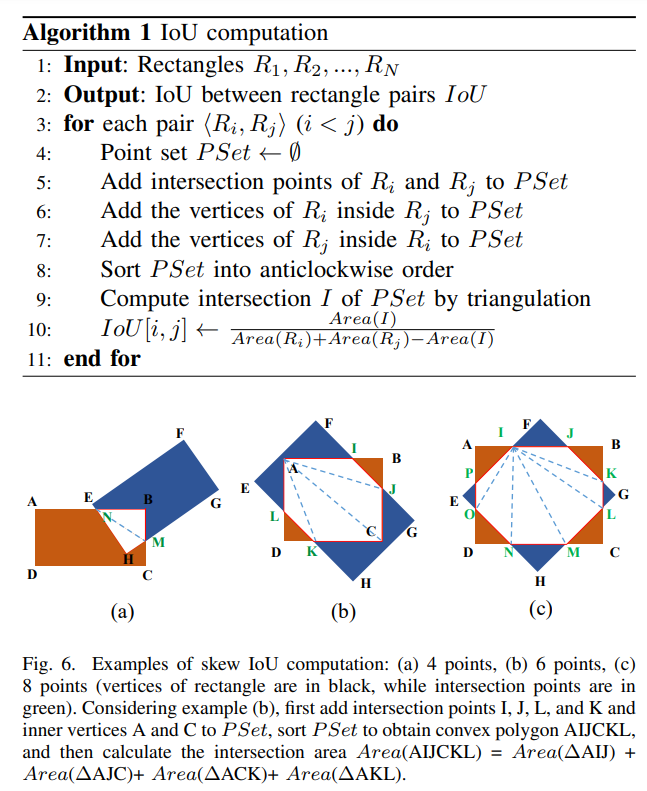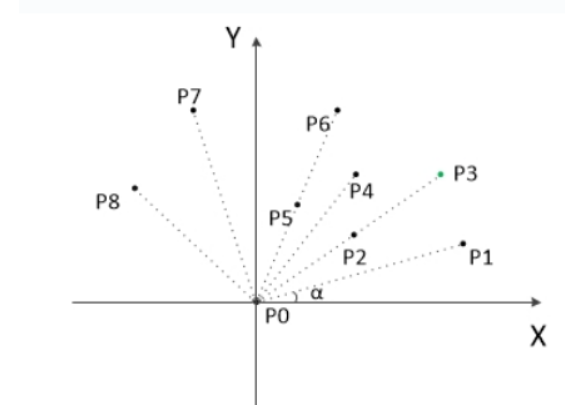斜框IOU实现
在目标检测时通常需要计算包围框的IOU,用于判断正负样本以及后续NMS过滤。框A和框B的IOU的值为其交集面积除以并集面积,
如果框为轴向包围盒,则可以参考IOU及NMS实现 ,但有时会遇到旋转框问题,这里对旋转框IOU计算方法做一个记录。
一、算法思路
参考论文 RRPN中提出的旋转框IOU计算方法

输入输出
- 输入: 由\((x, y, w, h, \theta)\)表示的一系列矩形,其中\((x, y)\)表示框的中心坐标,\(w\)表示框的宽度,\(h\)表示框的高度,\(\theta\)表示框由轴向包围框顺时针旋转至当前位置的角度。
- 输出: 任意两矩形之间的IOU值
算法步骤
对于任意两个四边形\(A\)和\(B\),其IOU计算如下:
- 将四边形\(A\)和\(B\)边的交点存于点集\(P_{set}\)
- 将\(A\)落在\(B\)内部的顶点存于点集\(P_{set}\)
- 将\(B\)落在\(A\)内部的顶点存于点集\(P_{set}\)
- 对点集\(P_{set}\)中点按照逆时针排序
- 三角化后计算三角形面积,其和即为交集面积\(Area_{A \cap B}\)
- \(IOU_{AB} = \frac{Area_{A \cap B}}{Area_{A} + Area_{B} - Area_{A \cap B}}\)
二、关键算子
2.1 坐标转换
以\((x, y, w, h, \theta)\)表示矩形,在计算点集\(P_{set}\)时需要依据矩形四个顶点坐标,所以需要弄清楚中间转换过程。

如上图所示,红色框\(A'B'C'D'\)为目标斜框,绿色框\(ABCD\)表示轴向框,轴向框顺时针旋转\(\theta\)后得到目标斜框,现需要求出斜框各顶点\(A', B', C', D'\)的坐标。
步骤1:中心点到轴向框顶点向量
依据中心点\(O'(x, y)\)和框的宽度\(w\)和高度\(h\)可以得到中心点\(O'\)到轴向框各顶点坐标的向量分别为\(O'A(\frac{w}{2}, \frac{h}{2}) \quad O'B(\frac{w}{2}, -\frac{h}{2})\), \(O'C(-\frac{w}{2}, -\frac{h}{2}) \quad O'D(-\frac{w}{2}, \frac{h}{2})\)
步骤2:向量顺时针旋转\(\theta\)
参考博客:平面向量旋转可知,顺时针旋转其旋转矩阵为
所以向量\(O'A' = T \cdot O'A, \quad O'B' = T \cdot O'B, \quad O'C' = T \cdot O'C, \quad O'D' = T \cdot O'D\)
以\(O'A'\)求解为例,其横坐标\(X_{O'A'} = cos\theta * \frac{w}{2} + sin\theta * \frac{h}{2}\), 纵坐标\(Y_{O'A'} = -sin\theta * \frac{w}{2} + cos\theta * \frac{h}{2}\)
所以
\(O'A'(w * cos\theta * 0.5 + h * sin\theta * 0.5, -w * sin\theta * 0.5 + h * cos\theta * 0.5)\)
因此:顶点\(A'\)的坐标为:
\(A'(x + w * cos\theta * 0.5 + h * sin\theta * 0.5, y - w * sin\theta * 0.5 + h * cos\theta * 0.5)\)
同理:
\(O'B'(w * cos\theta * 0.5 - h * sin\theta * 0.5, -w * sin\theta * 0.5 - h * cos\theta * 0.5)\)
\(O'C'(-w * cos\theta * 0.5 - h * sin\theta * 0.5, w * sin\theta * 0.5 - h * cos\theta * 0.5)\)
\(O'D'(-w * cos\theta * 0.5 + h * sin\theta * 0.5, w * sin\theta * 0.5 + h * cos\theta * 0.5)\)
所以有:
\(B'(x + w * cos\theta * 0.5 - h * sin\theta * 0.5, y - w * sin\theta * 0.5 - h * cos\theta * 0.5)\)
\(C'(x - w * cos\theta * 0.5 - h * sin\theta * 0.5, y + w * sin\theta * 0.5 - h * cos\theta * 0.5) ==> C'(2x - X_{A'}, 2y - Y_{A'})\)
\(D'(x - w * cos\theta * 0.5 + h * sin\theta * 0.5, y + w * sin\theta * 0.5 + h * cos\theta * 0.5) ==> D'(2x - X_{B'}, 2y - Y_{B'})\)
代码实现
struct RotatedBox {
float x_ctr, y_ctr, w, h, a;
};
struct Point {
float x, y;
Point(const float& px = 0, const float& py = 0) : x(px), y(py) {}
Point operator+(const Point& p) const {
return Point(x + p.x, y + p.y);
}
Point& operator+=(const Point& p) {
x += p.x;
y += p.y;
return *this;
}
Point operator-(const Point& p) const {
return Point(x - p.x, y - p.y);
}
Point operator*(const float coeff) const {
return Point(x * coeff, y * coeff);
}
}
void GetRotatedVertices(const RotatedBox& box, Point(&pts)[4]) {
// M_PI / 180. == 0.01745329251
double theta = box.a * 0.01745329251;
float cosTheta2 = (float)cos(theta) * 0.5f;
float sinTheta2 = (float)sin(theta) * 0.5f;
// y: top --> down; x: right --> left
pts[0].x = box.x_ctr + sinTheta2 * box.h + cosTheta2 * box.w;
pts[0].y = box.y_ctr + cosTheta2 * box.h - sinTheta2 * box.w;
pts[1].x = box.x_ctr - sinTheta2 * box.h + cosTheta2 * box.w;
pts[1].y = box.y_ctr - cosTheta2 * box.h - sinTheta2 * box.w;
pts[2].x = 2 * box.x_ctr - pts[0].x;
pts[2].y = 2 * box.y_ctr - pts[0].y;
pts[3].x = 2 * box.x_ctr - pts[1].x;
pts[3].y = 2 * box.y_ctr - pts[1].y;
}
2.2 线段求交
代码实现
double EPS = 1e-5;
float Cross2d(const Point & A, const Point & B) {
return A.x * B.y - B.x * A.y;
}
bool Insert(const Point& A, const Point& B, const Point& C, const Point&D, Point&P)
{
Point AB = B - A;
Point CD = D - C;
float det = Cross2d(CD , AB);
// This takes care of parallel lines
if (std::fabs(det) <= 1e-14) {
return false;
}
Point AC= C - A;
double t = Cross2d(CD, AC) / det;
double u = Cross2d(AB, AC) / det;
if (t > -EPS && t < 1.0f + EPS && u > -EPS && u < 1.0f + EPS) {
P = A + AB * t;
return true;
}
}
2.3 点是否在多边形内部
参考常见几何问题中第1个内容:点是否在多边形内部,可以采用其中射线法的思路。
但这里框是矩形,所以可以采用以下更简单的判别方法。

如上图所示,如果点\(P\)在矩形内部,则:
\(\vec{AP}\) 到\(\vec{AB}\)的投影长度小于或等于\(\vec{AB}\)的长度且\(\vec{AP}\) 到\(\vec{AD}\)的投影长度小于或等于\(\vec{AD}\),
其中投影可以采用向量点乘计算
相反如果点\(P\)在矩形外部,则:
\(\vec{AP}\) 到\(\vec{AB}\)的投影长度大于\(\vec{AB}\)的长度且\(\vec{AP}\) 到\(\vec{AD}\)的投影长度大于\(\vec{AD}\)
代码实现
double EPS = 1e-5;
float Dot2d(const Point & A, const Point & B) {
return A.x * B.x + A.y * B.y;
}
bool IsInner(const Point& A, const Point&B, const Point& C, const Point&D, const Point& P){
const Point& AB = B - A;
const Point& AD = D - A;
float ABdotAB = Dot2d(AB, AB);
float ADdotAD = Dot2d(AD, AD);
Const Point& AP = P - A;
float APdotAB = Dot2d(AP, AB);
float APdotAD = Dot2d(AP, AD);
if ((APdotAB > -EPS) && (APdotAD > -EPS) && (APdotAB < ABdotAB + EPS) && (APdotAD < ADdotAD + EPS)) {
return true;
}
return false;
}
2.4 点集排序
由于矩形框相交形成的相交区域都是凸区域,所以可以借助凸包来完成逆时针排序。
参考博客凸包(Convex Hull)问题算法详解以及凸包算法(Graham扫描法), 这里采用Graham(格拉翰)扫描法
博主给了个动图,很好的演示了算法流程, 动图地址请==>动图

算法步骤
- 先找出y值最小的点,如果存在y值相等,则优先选择x值最小的作为起始点\(P_{0}\),该点一定处于凸包上;
- 以\(P_{0}\)作为原点,其他所有点减去\(P_{o}\)得到对应的向量;

- 计算所有向量与\(X\)轴正向的夹角\(\alpha\),按从小到大进行排列,遇到\(\alpha\)相同的情况,则向量较短(即离\(P_{0}\)较近的点)的排在前面,得到初始点序\(P_{1}, P_{2}, ..., P_{n}\),由几何关系可知点序中第一个点\(P_{1}\)和最后一个点\(P_{n}\)一定在凸包上;
- 将\(P_{0}\)和\(P_{1}\)压入栈中,将后续点\(P_{2}\)作为当前点,跳转第8步;
- 栈中最上面那个点形成向量\(P_{ij}, i < j\), 利用叉乘判断当前点是否在该向量的左边还是右边或者向量上
- 如果在左边或者向量上,则将当前点压入栈中,下一个点作为当前点,跳转第8步
- 如果当前点在向量右边,则表明栈顶元素不在凸包上,将栈顶元素弹出,跳转第5步;
- 判断当前点是否是最后一个元素,如果是则将其压缩栈中,栈中所有元素即是凸包上所有点,算法结束,否则跳到第5步。
代码实现
int ConvexHullGraham(const std::vector<Point> &p, std::vector<Point> &q, bool bShiftToZero = false)
{
const numIn = p.size();
q.resize(numIn);
// Step 1:
// Find point with minimum y
// if more than 1 points have the same minimum y,
// pick the one with the minimum x.
int t = 0;
for (int i = 1; i < numIn; i++) {
if (p[i].y < p[t].y || (p[i].y == p[t].y && p[i].x < p[t].x)) {
t = i;
}
}
Point& start = p[t]; // starting point
// Step 2:
// Subtract starting point from every points (for sorting in the next step)
for (int i = 0; i < numIn; i++) {
q[i] = p[i] - start;
}
// Swap the starting point to position 0
Point tmp = q[0];
q[0] = q[t];
q[t] = tmp;
// Step 3:
// Sort point 1 ~ numIn according to their relative cross-product values
// (essentially sorting according to angles)
// If the angles are the same, sort according to their distance to origin
float dist(numIn);
#if defined(__CUDACC__) || __HCC__ == 1 || __HIP__ == 1
// compute distance to origin before sort, and sort them together with the
// points
for (int i = 0; i < numIn; i++) {
dist[i] = Dot2d(q[i], q[i]);
}
// CUDA version
// In the future, we can potentially use thrust
// for sorting here to improve speed (though not guaranteed)
for (int i = 1; i < numIn - 1; i++) {
for (int j = i + 1; j < numIn; j++) {
float crossProduct = Cross2d(q[i], q[j]);
if ((crossProduct < -1e-6) || (std::fabs(crossProduct) < 1e-6 && dist[i] > dist[j])) {
Point qTmp = q[i];
q[i] = q[j];
q[j] = qTmp;
Point distTmp = dist[i];
dist[i] = dist[j];
dist[j] = distTmp;
}
}
}
#else
// CPU version
std::sort(
q + 1, q + numIn, [](const Point& A, const Point& B) -> bool {
float temp = Cross2d(A, B);
if (std::fabs(temp) < 1e-6) {
return Dot2d(A, A) < Dot2d(B, B);
} else {
return temp > 0;
}
});
// compute distance to origin after sort, since the points are now different.
for (int i = 0; i < numIn; i++) {
dist[i] = Dot2d(q[i], q[i]);
}
#endif
// Step 4:
// Make sure there are at least 2 points (that don't overlap with each other)
// in the stack
int k; // index of the non-overlapped second point
for (k = 1; k < numIn; k++) {
if (dist[k] > 1e-8) {
break;
}
}
if (k == numIn) {
// We reach the end, which means the convex hull is just one point
q[0] = p[t];
return 1;
}
q[1] = q[k];
int m = 2; // 2 points in the stack
// Step 5:
// Finally we can start the scanning process.
// When a non-convex relationship between the 3 points is found
// (either concave shape or duplicated points),
// we pop the previous point from the stack
// until the 3-point relationship is convex again, or
// until the stack only contains two points
for (int i = k + 1; i < numIn; i++) {
while (m > 1) {
auto q1 = q[i] - q[m - 2], q2 = q[m - 1] - q[m - 2];
// Cross2d() uses FMA and therefore computes round(round(q1.x*q2.y) -
// q2.x*q1.y) So it may not return 0 even when q1==q2. Therefore we
// compare round(q1.x*q2.y) and round(q2.x*q1.y) directly. (round means
// round to nearest floating point).
if (q1.x * q2.y >= q2.x * q1.y)
m--;
else
break;
}
// Using double also helps, but float can solve the issue for now.
// while (m > 1 && Cross2d(q[i] - q[m - 2], q[m - 1] - q[m - 2])
// >= 0) {
// m--;
// }
q[m++] = q[i];
}
// Step 6 (Optional):
// In general sense we need the original coordinates, so we
// need to shift the points back (reverting Step 2)
// But if we're only interested in getting the area/perimeter of the shape
// We can simply return.
if (!bShiftToZero) {
for (int i = 0; i < m; i++) {
q[i] += start;
}
}
return m;
}
参考链接
Arbitrary-Oriented Scene Text Detection via Rotation Proposals
Rotated IoU 计算旋转矩形之间的重叠面积
Detector2




 浙公网安备 33010602011771号
浙公网安备 33010602011771号